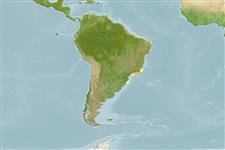Actinopterygii (ray-finned fishes) >
Perciformes (Perch-likes) >
Opistognathidae (Jawfishes)
Etymology: Opistognathus: Greek, opisthe = behind + Greek, gnathos = jaw (Ref. 45335); brasiliensis: Named after Brazil, along whose coast this species appears to be endemic (Ref. 26893).
Environment / Climate / Range
Ecology
Marine; demersal; depth range 50 - 69 m (Ref. 26893). Subtropical, preferred ?
Southwest Atlantic: known only from southern Brazil.
Size / Weight / Age
Maturity: Lm ? range ? - ? cm
Max length : 12.9 cm SL male/unsexed; (Ref. 26893)
Short description
Morphology | Morphometrics
Dorsal
spines
(total): 11;
Dorsal
soft rays
(total): 16;
Anal
spines: 3;
Anal
soft rays: 15 - 16;
Vertebrae: 28. Anterior nostril a short tube with simple cirrus on posterior rim; posterior end of maxilla of adult males produced as a thin flexible lamina that usually extends beyond posterior margin of opercle; spinous dorsal fin with black spot encircled by a very narrow white ring; dorsal fin with 5 or 6 dusky bands that extend onto dorsum; adult males with inner lining of maxilla and adjacent membranes with 2 dark stripes, one stripe in females; pectoral fin uniformly pigmented, no black speckles proximally; buccal pigmentation consisting of a dark area widely surrounding esophageal opening except for a pale area posteriorly that continues between upper pharyngeal tooth patches; caudal vertebrae 8 (Ref. 26893).
Mouthbrooders (Ref. 240).
Life cycle and mating behavior
Maturity | Reproduction | Spawning | Eggs | Fecundity | Larvae
Employ mouthbrooding to care for their young (Ref. 240).
Smith-Vaniz, W.F., 1997. Five new species of jawfishes (Opistognathus: Opistognathidae) from the western Atlantic ocean. Bull. Mar. Sci. 60(3):1074-1128. (Ref. 26893)
IUCN Red List Status (Ref. 115185)
CITES (Ref. 94142)
Not Evaluated
Threat to humans
Harmless
Human uses
More information
Age/SizeGrowthLength-weightLength-lengthLength-frequenciesMorphometricsMorphologyLarvaeLarval dynamicsRecruitmentAbundance
ReferencesAquacultureAquaculture profileStrainsGeneticsAllele frequenciesHeritabilityDiseasesProcessingMass conversion
Tools
Special reports
Download XML
Internet sources
